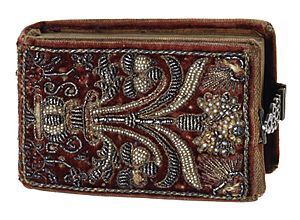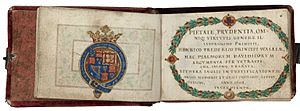Esther Inglis facts for kids
Quick facts for kids
Esther Inglis
|
|
|---|---|
 |
|
| Born | 1571 |
| Died | 1624 (aged 52–53) Edinburgh, Scotland
|
| Nationality | Scottish |
| Known for | Calligraphy, textiles |
Esther Inglis (1571–1624) was an amazing artist from Scotland. She was super skilled in many areas. She was a master of calligraphy (beautiful handwriting), writing, and even embroidery.
Esther was born in 1571, possibly in London or Dieppe, France. Later, she moved to Scotland, where she grew up and got married. Esther was special because she always signed her artwork. She often drew herself writing in her books. Unlike some other artists, Esther built a successful career. She made many special books for kings and queens.
During her life, Esther created about sixty tiny books. These books showed off her amazing calligraphy skills. They also had paintings, portraits, and even embroidered covers. She usually gave her books to important people. These included Queen Elizabeth I and King James VI and I. Esther Inglis died around 1624, when she was about 53 years old.
Contents
Early Life
Esther Inglis was born to Nicholas Langlois and Marie Pressot in 1571. Her father, Nicholas, was a schoolteacher. He later became the head of the French School in Edinburgh. Her mother, Marie, was also a very talented calligrapher.
Both of Esther's parents came from France. They likely moved to Scotland around 1569. They were Protestant refugees, meaning they fled France to escape religious persecution.
It is believed that Esther learned a lot from her parents. Her father probably taught her many subjects. Her mother almost certainly taught her the art of calligraphy. Esther herself once wrote that her parents encouraged her. She said her writing helped her through tough times.
Esther was very lucky to have such skilled parents. They gave her an advanced education at home. This was not common for girls at the time. But some other women also learned this way. Her father, Nicholas Langlois, passed away around 1613. Her mother, Marie Pressot, continued to live in Edinburgh.
Marriage and Career
Esther's father first helped manage her career. He wrote special poems for her early books. After Esther married Bartholomew Kello in 1596, he took over. Kello was very proud of Esther's talents. He often signed himself as "husband of the book’s adorner."
Kello worked for King James VI's court. Esther often worked as his scribe, meaning she copied documents for him. King James VI even wrote that Kello should make sure "the most exquisite writer within this realm" did the work. This likely meant Esther.
Kello's job was to create many documents. These included passports and letters. While Esther made these for him, she also created many "gift books." Kello would deliver these documents. He would also include one of Esther's beautiful gift books. He probably hoped for a reward in return.
Esther's books were truly special. She added impressive drawings on the title pages. She also created unique borders on every page. Her handwritten books were so perfect they looked like printed works. At this time, handmade books were becoming very valuable. This was because printing was becoming more common.
Esther's books were also very tiny. The smallest ones were only about one and a half inches by two inches. Esther Inglis is also known as one of only three women painters in Scotland before the 1700s.
Esther and Kello were not just married; they were also business partners. They moved to England around 1606. They hoped to continue their work there. They returned to Edinburgh around 1615. Esther lived there until her death in 1624.
Early Manuscripts: 1605–1607
Esther presented her first book in England in 1605. It was for Susanna Herbert, someone Esther didn't know personally. The book contained religious texts and fancy alphabets. It was made to show off Esther's amazing calligraphy skills. Esther probably hoped to get a job or a reward from Herbert.
After 1605, Esther started giving her books directly to people. In 1606, she gave New Year's gift books to three important people. These people were also strangers to her. These new books showed a different style. They were smaller and oblong. Each page had a colorful flower or a small bird. The title pages had flowered borders. This oblong shape was very unique.
These gift books were still meant to show off her skills. Each page had a different style of handwriting. Instead of alphabets, there were colorful birds, flowers, or butterflies.
Esther often used published books for her ideas. Artists back then often copied text from other books. They would then add their own special handwriting and designs. Esther would also make several copies of the same book. But she would write different dedications for each person.
In 1606, King Christian of Denmark visited England. He was with Chancellor Christianus Friis, who was known for being generous. Esther made another flower-illustrated book for Friis. She probably hoped for a good reward. This book was similar to her New Year's gifts. But it had different flowers from a popular series called Florae Deae.
Esther might not have been the most "inventive" artist. But she was incredibly skilled. She made sure everyone knew her work was worth buying and collecting. She often wrote in her gifts, "written and illuminated by me, Esther Inglis."
Prince Henry's Patronage: 1607–1614
Esther mostly made her flower-illustrated books in 1606 and 1607. After 1607, she made fewer books. We don't know exactly why. But some people think the illustrations became less popular. Or maybe they took too much time to make.
Another idea is that Esther found a special patron at Prince Henry's court. A patron is someone who supports an artist financially. This support, plus her husband's income, might have given them enough money. So, she didn't need to make as many books to earn a living.
From 1607 to 1614, Esther made only eight known books. Five of these were for Prince Henry or Sir David Murray. She rarely approached other patrons during this time. This suggests she had found good support from Prince Henry's household.
Personalization of Books
Early in her career, Esther got ideas from printed books. She often copied fancy borders and designs. Two of her most beautiful books are C.L. Psaumes de David (1599) and Le Livre de l'Ecclesiaste (1601).
These books were special because they were made for the person receiving them. For example, the book for Prince Maurice had drawings of armor and weapons. This was perfect for him, as he was a prince who spent a lot of time fighting.
Later, Esther started using color in her drawings. She illustrated different flowers, fruits, and small animals. These often appeared in the borders of her books.
Esther also embroidered her work. She made beautiful, jewel-like covers for her books for royalty. These covers were often made with tiny pearls and gold or silver thread on red velvet. The covers perfectly matched the amazing calligraphy and artwork inside.
Protestant Involvement
Esther's parents were Protestants. They left France because Protestants were being persecuted there. So, it's very likely Esther was raised as a Protestant too. Esther and her husband were known to support the Protestant religion.
Many of Esther's books were given as gifts to Protestants. These included people around Queen Elizabeth I and King James VI.
Out of about sixty books by Esther, most are copies of Protestant religious texts. These included psalms from the Geneva Bible. She also copied verses from Proverbs and Ecclesiastes. She even copied works by famous French religious writers.
Children
Esther Inglis had four children who survived. We only know the name of one son, Samuel. He later took over his father's job as Rector of Spexhall.
Two other sons, Isaac and Joseph, are buried in a church in Essex, England. Their father, Bartholomew, was a rector there. Two simple plaques in the church remember them.
Images for kids
See also
 In Spanish: Esther Inglis para niños
In Spanish: Esther Inglis para niños




